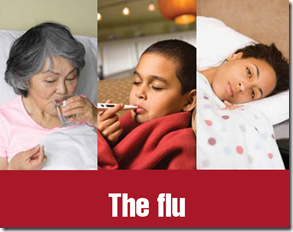Photo Credit CDC Influenza Home Care Guide
# 5837
We’ve a new study appearing in BMJ Open that looks at just how accurate self diagnosis of influenza during the 2009 pandemic really was.
First, a little background.
ILIs . . . or Influenza-like Illnesses are among the most common maladies reported to doctors each year, and while often attributed to `flu’, the causes extend far beyond influenza.
The symptoms generally include fever, cough, and body aches - but may also commonly include rhinitis, sneezing, headache, fatigue, sore throat, nausea & vomiting, and diarrhea.
Influenza A & B, which get most of the headlines, are only responsible for a fraction of the cases of ILI each year. Some estimates put that share as low as 10%.
According to the CDC, each year adults (on average) experience 1 to 3 bouts with an ILI, while children may see 3 to 6 flu-like illnesses (cite MMWR)
Most of these viral infections are mild, self-limiting, and are almost never identified since testing (beyond, perhaps, a rapid influenza test) is rarely warranted.
Which is why doctors generally refer to ILIs, or Influenza-like Illnesses (or sometimes ARI Acute Respiratory Infection), when making a clinical diagnosis.
If an ILI is mild, most people chalk it up to the `common cold’, and if it is more debilitating, figure it is `the flu’.
But in reality the spectrum of common respiratory viruses is far more diverse; metapneumovirus, parainfluenzavirus, coronaviruses, respiratory syncytial virus (RSV), enteroviruses, any of the myriad Rhinoviruses (Common cold), and a number of varieties of adenovirus.
The prevalence of these non-flu ILI’s complicate the job for doctors and public health officials during a pandemic when limited resources (hospital beds, antivirals, etc) must be prioritized and people must decide whether to go to the ER or self isolate if symptomatic.
Which brings us to today’s study, where researchers surveyed more than 1100 people from New Zealand during the 2009 pandemic and compared their perception of whether they caught the flu that year with blood tests showing antibodies to the novel H1N1 virus.
Self-diagnosis of influenza during a pandemic: a cross-sectional survey
Annemarie Jutel1, Michael G Baker2, James Stanley2, Q Sue Huang3, Don Bandaranayake4
BMJ Open 2011;1:e000234 doi:10.1136/bmjopen-2011-000234
Abstract
Background Self-diagnosis of influenza is an important component of pandemic control and management as it may support self-management practices and reduce visits to healthcare facilities, thus helping contain viral spread. However, little is known about the accuracy of self-diagnosis of influenza, particularly during pandemics.
Methods We used cross-sectional survey data to correlate self-diagnosis of influenza with serological evidence of 2009 pandemic influenza A(H1N1) infection (haemagglutination inhibition titres of ≥1:40) and to determine what symptoms were more likely to be present in accurate self-diagnosis. The sera and risk factor data were collected for the national A(H1N1) seroprevalence survey from November 2009 to March 2010, 3 months after the first pandemic wave in New Zealand (NZ).
Results The samples consisted of 318 children, 413 adults and 423 healthcare workers. The likelihood of being seropositive was no different in those who believed they had influenza from those who believed they did not have influenza in all groups.
Among adults, 23.3% (95% CI 11.9% to 34.7%) of those who reported having had influenza were seropositive for H1N1, but among those reporting no influenza, 21.3% (95% CI 13% to 29.7%) were also seropositive.
Those meeting NZ surveillance or Ministry of Health influenza case definitions were more likely to believe they had the flu (surveillance data adult sample OR 27.1, 95% CI 13.6 to 53.6), but these symptom profiles were not associated with a higher likelihood of H1N1 seropositivity (surveillance data adult sample OR 0.93, 95% CI 0.5 to 1.7).
Conclusions Self-diagnosis does not accurately predict influenza seropositivity. The symptoms promoted by many public health campaigns are linked with self-diagnosis of influenza but not with seropositivity. These findings raise challenges for public health initiatives that depend on accurate self-diagnosis by members of the public and appropriate self-management action.
I’ve only printed excerpts from the abstract, but the entire study is open access, and freely available. The key finding (below) is well illustrated by one of the charts accompanying the study:
The likelihood of being seropositive was no different in those who believed they had influenza from those who believed they did not have influenza in all groups.

In this study, roughly 75% of the people who thought they caught the pandemic flu that fall did not. While nearly 25% who believed they had not contracted the virus actually had.
Even among healthcare workers, the percentage who correctly diagnosed themselves with the pandemic flu was only 33%.
And those who reached the conclusion that they had contracted the flu after consultation with a healthcare professional were wrong most of the time as well.

Not only can the misidentification of influenza cause serious problems during a pandemic, it also likely skews the public’s perception of the effectiveness of the yearly flu vaccine.
Many people complain that in years when they got the shot they still caught the flu. As this study shows, people often mistake non-flu ILIs (which are not covered by the shot) for influenza.
The major implication here is that during a pandemic, the majority of people seeking antivirals or medical care due to having flu-like symptoms are likely not to have the pandemic virus.
The authors of this study conclude:
These findings reinforce public health advice during the pandemic that patients should seek medical care on the basis of disease severity rather than for the purpose of diagnosis.
Of course, getting the public to go along with this advice during an influenza pandemic is going to be a lot easier said than done.

